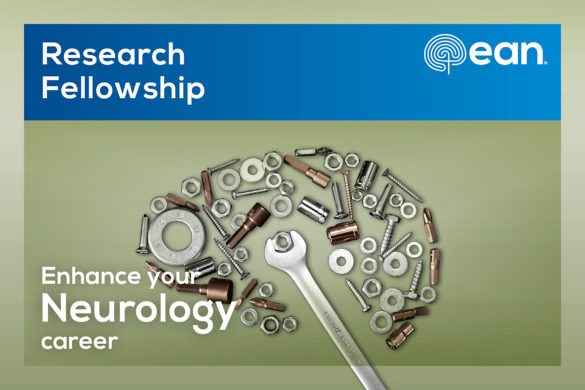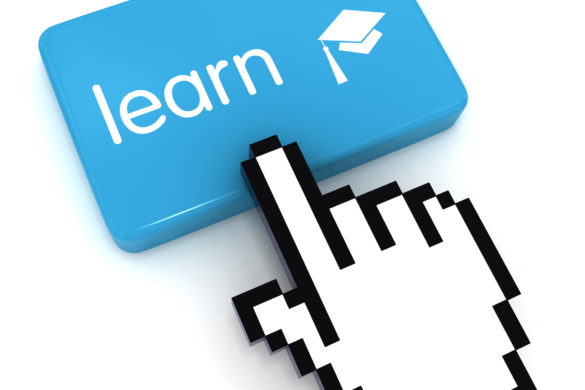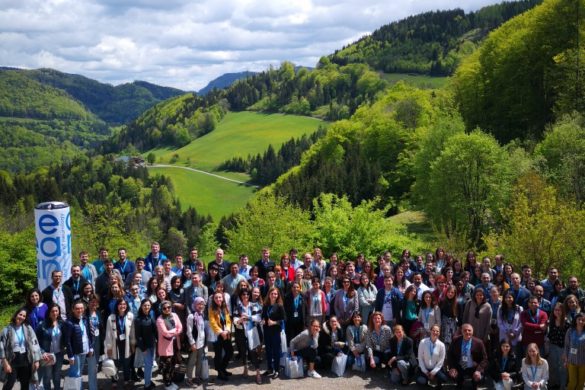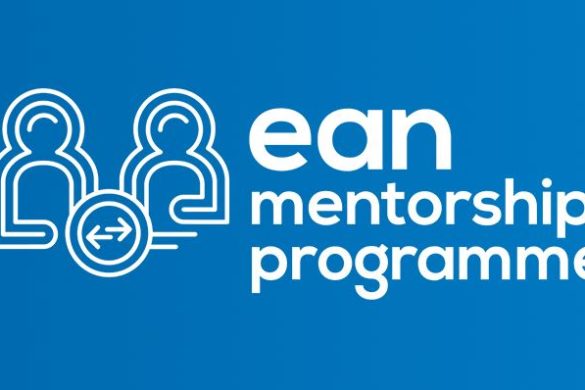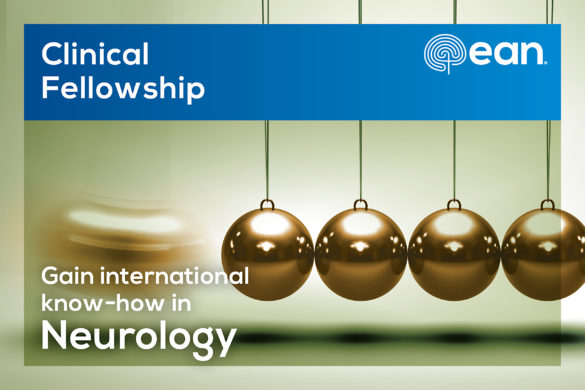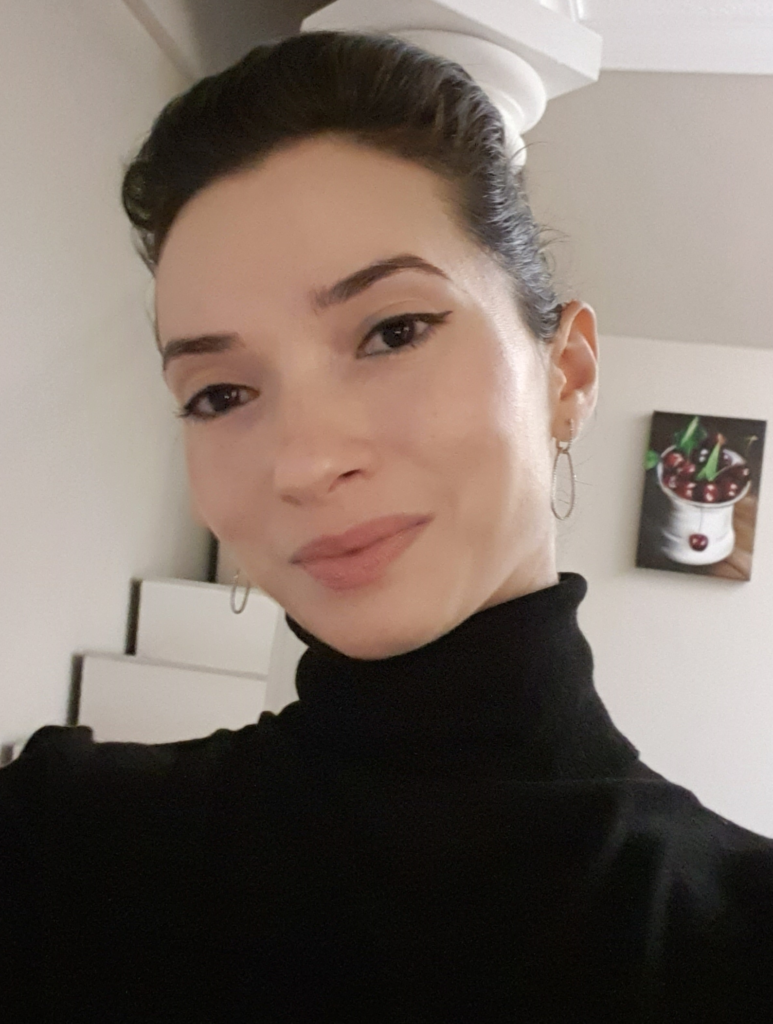
Anca Loredana Alungulese, Madrid, Spain
Term of Fellowship: 2 January – 31 March, 2022
Hosting department: Oxford Adult Muscle Service, John Radcliffe Hospital, Oxford, UK
Supervisor: Dr. Stefen Brady
It is with great pleasure that I report on my experience enabled by the EAN Clinical Fellowship programme. My training took place at the Oxford Adult Muscle Service, under the supervision of Dr. Stefen Brady. My main objective was to broaden my knowledge in muscle disorders.
The Oxford Adult Muscle Service (OMS) is a multidisciplinary service managing approximately 1,200 patients with rare and complex neuromuscular disorders. It comprises a specialist neuromuscular consultant, physiotherapist, and care advisor. I had the opportunity to attend the three OMS clinics every week and the fortnightly NHS Highly Specialised Rare Mitochondrial Disorders clinics. My stay at the OMS undoubtedly fulfilled my expectations. Being part of the daily clinical work of a centre with extensive expertise in muscle disease was a great learning experience. I will be forever thankful to Dr. Brady, my mentor during the training, for his much-appreciated clinical and scientific guidance, endless patience, for organising my fellowship and supporting me with all means throughout my stay at the clinic.
I am also very thankful to Heather Ryan, Laura Room, Hayley Pill, Jo Lowndes, Kate Sergeant and the whole NHS Rare Mitochondrial Disorders team for their warm welcome, pleasant working atmosphere and priceless feeling of being home. Their work inspired me to look differently at patient care, emphasising not only the expertise, but also the human touch.
Muscle biopsy remains important in investigating myopathies, so one of my objectives was to develop clearer insights into muscle pathology in order to enrich clinical life and enable me to communicate with pathology colleagues and, when results are available, to translate muscle biopsy results for patients’ benefit. I am very thankful to Dr. Monika Hofer who invested a great amount of her time in providing me with the knowledge to interpret muscle biopsy and reviewing many interesting cases.
According to my interest in electrophysiology, I have spent time at the Clinical Neurophysiology Department. Dr. Adam Molyneux kindly shared his electrodiagnostic testing tricks and allowed me to attend special studies such as single fibre electromyography.
I also had the opportunity to complement my clinical fellowship with neuromuscular paediatric clinics under the supervision of Dr. Sithara Ramdas. Moreover, I attended extra specialist clinics including muscle-cardiology clinic (Dr. Alex Pitcher), genetic counselling and NHS Highly Specialised Rare Congenital Myasthenia Service clinic.
In addition, I took full advantage of the wider learning opportunities available, including, but not limited to, weekly multidisciplinary meetings such as muscle-radiology meeting, muscle-genetics meeting, muscle-histopathology meeting and neurology ground rounds.
While in Oxford, I attended external neuromuscular teaching meetings including the Annual King’s Neuromuscular Disease Symposium and the Kansas University Medical Centre Neuromuscular Review Course.
I was offered the opportunity to join ongoing research projects in the group of my mentor, Dr. Brady, focusing on mitochondrial disease. I would like to express my gratitude to Dr. Louisa Kent for her kind support, constructive talks and friendship.
Last, but not least, my warmest gratitude goes to Dr. Jaclyn Nicole Le Grand for her continuous support and making possible meeting such amazing people.
Not only has this fellowship enabled me to gain insight into the clinical practice of a highly proficient team of muscle experts and to extend my knowledge in this field, but I was also able to learn about the healthcare and educational systems in the UK.
Finally, I would like to thank the European Academy of Neurology for this life-changing opportunity. I will truly cherish every moment I spent in Oxford and do my best to apply the acquired knowledge at my home department. I hold a warm hope for further encounters with the Oxford team at conferences and training events.
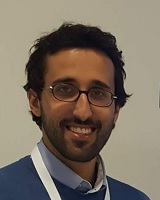
Rafael Azevedo Dias, São Mamede de Infesta, Portugal
Term of Fellowship: 4 January – 31 March, 2022
Hosting department: Department of Neurology, University Hospital Bern, Switzerland
Supervisor: Prof. Marcel Arnold
I would like to express my gratitude to the EAN Clinical Fellowship Programme and to the Department of Neurology, University Hospital Inselspital, Bern, Switzerland for the amazing opportunity to perform a 12-week clinical fellowship in the stroke unit and neurovascular department. It is one of the best centres in Europe regarding vascular neurology and stroke care, being in the forefront of stroke research, development of European stroke guidelines and promotion of several educational initiatives including the ESO ESMINT ESNR Stroke Winter School and the recent Master of Advanced Studies in Stroke Medicine Universität Bern (MAS Stroke Unibe).
During my fellowship, guided by Prof. Marcel Arnold and Dr. Mirjam Heldner, I tried to accompany the extraordinary team of doctors in the various activities performed related to the stroke patient and vascular neurology.
In the mornings I would accompany the residents and attending physicians in the stroke unit. We would start by evaluating and performing the neurological examination on admitted patients to ascertain the success of reperfusion therapies instituted in the emergency department, and then choose the proper studies performed in the first 24 hours after ischaemic stroke to identify the cause. I also accompanied the different attending physicians in the everyday visit of all admitted patients in the stroke unit, where all patients were examined together, the results of exams performed were reviewed and the management decided as a team. In that regard I would like to specially thank Dr. David Julian Seiffge as well as the other attending physicians and residents that took the time to guide me through their thought processes in the management of patients, allowing me to ask questions and clarifying any doubts I had. Although I had already trained in my own hospital stroke unit, I had the opportunity to see different methods of work. The use of magnetic resonance (MR) and angiography by MR was of added-value in suspecting rarer causes of stroke. I even had the opportunity to see the usage of a 7Tesla MR (not available in my country) to detect more thoroughly the vessels affected by a varicella-zooster vasculitis, which showed to be pivotal in the decision to use steroids and steroids-sparing agents in this case.
During the afternoons I would spend my time in the emergency department observing, together with the neurology emergency team, all the patients admitted. With focus in the stroke code, I had the opportunity to see the fast-paced management of these patients and the use of emergent MR in the selection of patients for reperfusion therapies namely thrombolysis and thrombectomy. This was an eye-opening experience; the number of patients treated outside of the conventional 4.5-hour thrombolysis treatment window due to the use of DWI-FLAIR mismatch was incredible and the benefit was huge. Most of the patients I observed in the emergency department, were also accompanied by me in the stroke unit. This continuum of care was an excellent opportunity for my training as I would be able to see the improvement of deficits from the ED to the Stroke Unit. Without a doubt I learned a lot with the emergency department team and was able to incorporate a few tricks to my own approach to the stroke code performed in my own hospital improving the overall care of these patients.
A few days a week i would also spend some time in the neurovascular unit where ultrasonography was performed. In January I acommpanied the doctors and ultrasonographers in the day-to-day performance of cervical, ophthalmic and transcranial ultrasound. I was able to learn a few different techniques in performing this important exam in the management of stroke patients. During February I had the opportunity to perform a few vascular ultrasounds with the supervision of the doctors and with the approval of the patients, improving my own technique in not only performing this exam but also in interpreting the different results. After performing the ultrasound I would accompany the doctors in their neurology consult with the patients, answering any doubts, and changing secondary prevention medications according to the state-of-the-art guidelines.
On my last month and due to the fact that haemorrhagic stroke patients were almost always admitted to the neuro-intermediate care unit (Neuro-IMC), I had the opportunity to accompany Prof. Werner Z’Graggen and resident doctors in the management of these patients. Every day we would do a round of all the admitted patients to the Neuro-IMC, updating the team on the progression of the haemorrhagic stroke and the management strategies employed. I would also participate in the rounds performed in the intensive care unit, as patients with strokes in need of level three intensive care would be managed by intensive care doctors and by the Neuro-IMC team, mainly by Prof. Z’Graggen. This multidisciplinary approach was of great value for the patient and would be an approach I would like to take back to my own hospital. I would also like to thank Prof. Z’Graggen and the residents of the Neuro-IMC for all the time spent guiding me through the patients, their diagnoses and their management approach. Here the use of multimodal neuromonitoring in aneurysmal subaracnoid hemorrhage to detect delayed cerebral ischaemia was different than I was used to, which proved to be a great learning opportunity for me.
During my fellowship I also participated in the different training meetings provided by the neurology department, where I had the opportunity to consolidate knowledge not only related to vascular neurology and stroke care but to different areas of neurology depending on the theme presented.
I also participated every week in the neurovascular board meeting, a multidisciplinary meeting with the vascular neurologists, neurosurgeons and interventional neuroradiologists to discuss and decide the best approach for high grade or symptomatic cervical/intracranial stenosis. This multidisciplinary discussion was perfect to see difficult cases and to participate in the discussion of the best approach to do on a case-by-case approach.
To finalise, I also participated on a research meeting where a proposed research project to be implemented was presented to the neurology team in order to receive input, constructive.
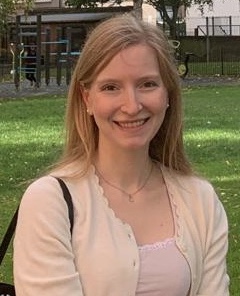
Francesca Baschieri, Bologna, Italy
Term of Fellowship: 1 January – 31 March, 2022
Hosting department: Department of Clinical and Movement Neurosciences, UCL Queen Square Institute of Neurology, London, UK
Supervisor: Prof. Kailash Bhatia
I am very pleased to write a positive report about my Clinical Fellowship at the Department of Clinical and Movement Neurosciences, UCL Queen Square Institute of Neurology in London (UK), under the supervision of Prof. Kailash Bhatia.
I was welcomed by Prof. Bhatia and his team, and it didn’t take long for me to settle. My weekly activities included the following: firstly, I regularly attended the movement disorders clinic, where I had the opportunity to evaluate patients with all types of movement disorders and to discuss with Prof. Bhatia and other members of his team the phenomenology as well as the diagnostic work-up to exclude differential diagnosis and therapeutic options. At the end of each clinic there was a resumé where all cases were briefly reviewed to make sure all the fellows learnt from every patient. Secondly, I attended Prof. Bhatia’s Botulinum toxin clinic where I learnt how to treat patients with dystonia, tics, hemifacial spasm and blepharospasm. Every week we attended the ward round, where cases were discussed and then assessed in the ward, usually patients presenting with a complex combination of movement disorders or atypical presentations of classic conditions.
In addition, I had the opportunity to attend several weekly academic teaching sessions, where clinical cases were presented and interactively discussed to reach a final diagnosis. I found this a very effective way to teach and also to remain up to date within other fields of neurology. Moreover, Prof. Bhatia organised a movement disorders video session for the team every month and lectures with eminent speakers about different topic related to movement disorders.
Unfortunately, due to COVID, some appointments (mainly follow-ups) were converted into telephone consultations, but nevertheless also these cases were always discussed and I could even learn from those.
This Clinical Fellowship gave me the opportunity to broaden my knowledge in the movement disorders field, particularly to increase my clinical skills in observing and recognising movement disorders, and to learn diagnostic and therapeutic approaches that I could apply to my daily clinical practice. I also had the opportunity to see many patients affected by rare diseases, mainly genetic, which are important as some of them are treatable. Hence the importance of knowing and recognising these conditions as well.
I am very grateful to the European Academy of Neurology for this valuable opportunity.





